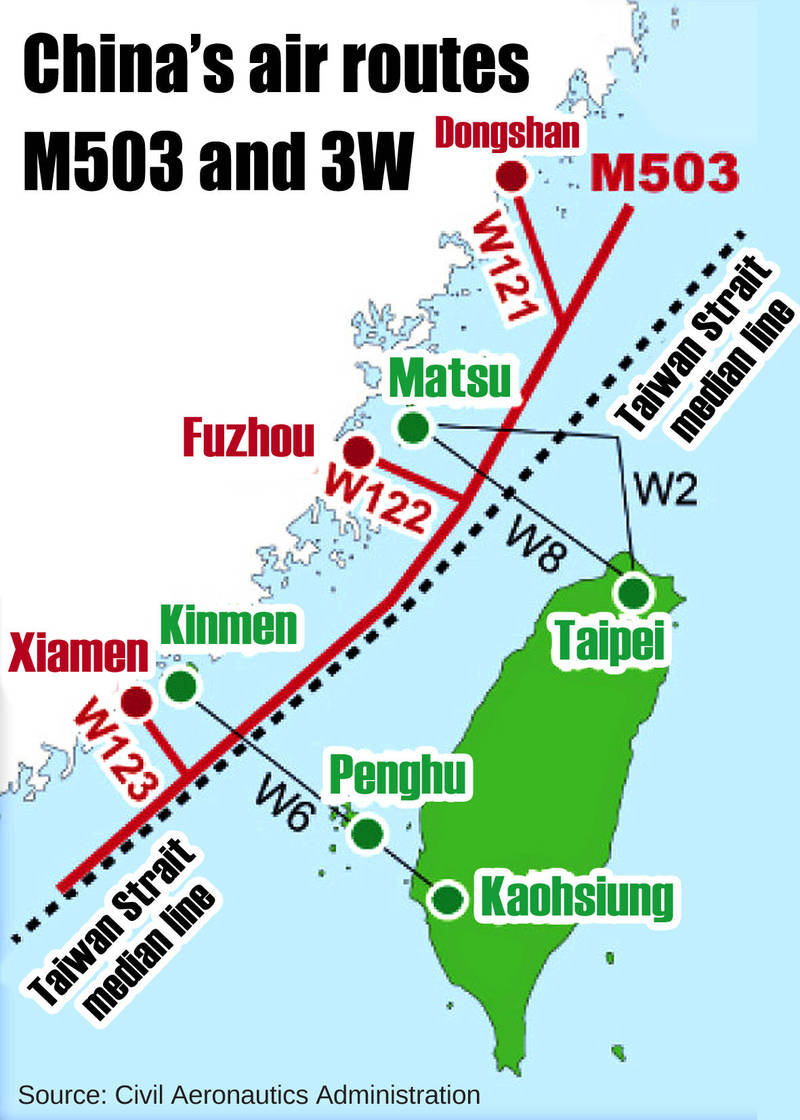《TAIPEI TIMES》 Officials protest risky flight path changes

China’s unilateral decision to allow flights to operate on its self-drawn M503, W122 and W123 flight routes without adjustment changes the “status quo” of the Taiwan Strait and puts flights to the outlying islands of Kinmen and Lienchiang (Matsu) counties at greater risk, government officials said yesterday.
‘IRRESPONSIBLE’: Beijing’s changes to flight routes elevates aviation risks, while complicating air traffic control and safety near Kinmen and Matsu, the CAA said
By Shelley Shan / Staff reporter
An agreement signed by Beijing and Taipei in March 2015 stipulated that only southbound flights were allowed on the M503 route, and the flights must operate 6 nautical miles (11.11km) west of the route. The agreement also required flights on the route to veer to the west if they encountered emergency situations, while the W121, W122 and W123 routes would not be launched until after both sides confirmed the details of their implementation.
Beijing first broke the agreement on Jan. 4, 2018, when it announced that northbound flights would be allowed on M503, while westbound flights would be permitted on W121, W122 and W123.
China yesterday said that all flights on M503 do not need to operate 6 nautical miles west of the route, adding that eastbound flights would be allowed on W122 and W123.
“The Chinese government ignored the agreement that both sides reached in 2015, and the unilateral move would severely affect aviation safety across the Taiwan Strait. The ploy, along with increasingly frequent flights of high-altitude balloons in Taiwan’s airspace, are designed to destroy the peace and stability across the Strait. We strongly condemn such inappropriate action,” Premier Chen Chien-jen (陳建仁) told reporters during a visit to the Taipei Flower Market (台北花卉產銷).
Civil aviation and national security officials are deliberating over proper responses to the move, Chen said.
The Civil Aeronautics Administration (CAA) in a statement said that Beijing’s decision in 2018 has already complicated air control operations on the west side of the Taipei Flight Information Region (FIR) and in the airspace around Kinmen and Matsu, adding that its decision yesterday has further complicated air traffic control in the areas.
“Such an irresponsible move not only adversely affects the aviation safety of flights to Kinmen and Matsu, but it also elevates risks for other flights passing through the region. China must be held responsible for all the possible consequences of its action,” it said.
Under International Civil Aviation Organization guidelines, China must negotiate with all stakeholders along its flight routes should it seek to adjust them, the CAA said.
Taiwan and China must address safety issues involved with changes to the M503, W122 and W123 routes, given that M503’s closest point to the Taipei FIR is only 4.2 nautical miles, while W122 is only 2.8 nautical miles from the south terminal airspace of Matsu, it said.
The narrowest buffer zone between W123 and Kinmen’s airspace is 1.1 nautical miles, it added.
“We strongly protest China’s unilateral changes to the use of the three flight routes and demand that both sides negotiate a resolution as quickly as possible,” the agency said. “Air traffic controllers in Taipei, Kinmen and Matsu will closely monitor the flights operating within these areas and demand that Chinese air traffic controllers guide Chinese aircraft away from Taiwan’s airspace.”
Ministry of National Defense spokesman Sun Li-fang (孫立方) also called China’s unilateral move “irrational” and “destructive,” as it could easily escalate the tension and destroy stability in the region.
“The military would continue to monitor the situation around Taiwan through our joint intelligence, surveillance and reconnaissance operations, and handle unidentified flying objects intruding upon our air defense identification zone in accordance with our standard procedures,” Sun said.
The Ministry of Foreign Affairs also urged the international community to demand China negotiate with Taiwan over the changes.
新聞來源:TAIPEI TIMES



















